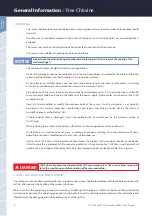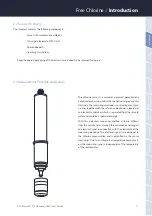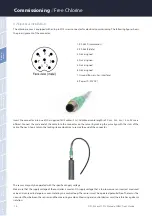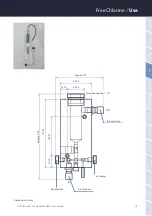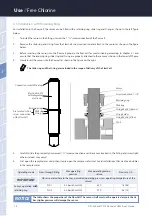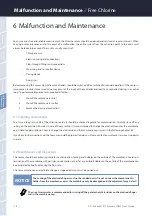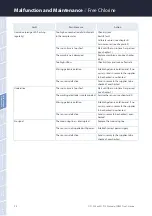
17
Us
e
Us
e
Calibr
ation
Calibr
ation
M
alfunc
tion and
M
ain
tenanc
e
M
alfunc
tion and
M
ain
tenanc
e
Comm-
issioning
Comm-
issioning
In
tr
oduc
tion
In
tr
oduc
tion
G
ener
al
Inf
or
ma
tion
G
ener
al
Inf
or
ma
tion
FA
Q
FA
Q
Technical
Da
ta
Technical
Da
ta
W
ar
ran
ty
W
ar
ran
ty
Cust
omer
ser
vic
e
Cust
omer ser
vic
e
Con
tac
t
Con
tac
t
Key
w
or
d
Inde
x
Key
w
or
d
Inde
x
Ac
cessor
ies
Ac
cessor
ies
D01-905en201912 Manual eCHEM Free Chlorine
Free Chlorine
//
Calibration
5.3 Measurement properties
The following instructions must be observed when operating the sensor:
•
The sensor must be operated in an upright position so that the incoming flow of sample water comes from below
up against the membrane.
•
Outgassing sample water interferes with the measurement. During unpressurised operation
with free outflow of the sample water gas bubbles have no disturbing effect as long as they
do not cover the membrane. Gas bubbles in front of the membrane prevent the free chlorine from
entering the electrolyte, which falsifies the measuring signal.
•
A minimum inflow velocity (>15 L/h) is required. The flow rate must be constant.
•
The service life of the membrane is typically 1 year, but it depends very much on the water quality. Heavy
soiling of the membrane must be avoided!
•
The supply voltage of the sensor must not be switched off during interval operation of the measuring
system. The sensor must be permanently connected to the supply voltage. The sensor must not
stand dry.
•
The sensor must not be operated for a longer period of time (>1 day) in chlorine free water. There is a risk
that deposits/soiling (e.g. biological) will form on the membrane, which will hinder or block subsequent chlorine
measurement. After operating the sensor in chlorine-free water, run-in times must be expected. If necessary,
switch on dosing with a time delay. If no chlorine is expected over a longer period of time, the sensor must be
separated from the controller, removed and stored in a dry place.
•
The presence of reducing and oxidizing agents as well as corrosion inhibitors can interfere with the
measurement.
Summary of Contents for Free Chlorine
Page 1: ...Free Chlorine OPERATING INSTRUCTIONS...
Page 2: ......


